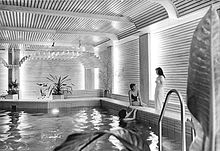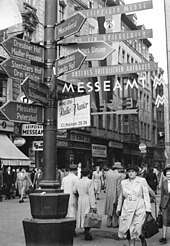Prostitution in the German Democratic Republic
Although prostitution was prohibited by law in the German Democratic Republic since 1968, it was partially tolerated afterwards.
Of the State Security was prostitution used for their purposes.
A quote from Uta Falck sums up the circumstances of prostitution as follows: “ Everyone involved benefited from prostitution in the GDR : the rich women, the satisfied suitors, the informed state. There will hardly ever be so much satisfaction in this trade. "
history
1945 to 1955
After the Second World War , prostitution served primarily to secure a livelihood. The main focus of the state during this time was the containment of infectious diseases. The incidence of sexually transmitted diseases was 1%. Sick prostitutes were usually admitted to care homes and closed hospital wards to treat the disease and change their way of life. Compulsory serial examinations of (mainly female) guests of amusement bars as well as health strips from employees of the state health authorities and the police were carried out to curb the transmission of sexually transmitted diseases.
1955 to 1968
From the mid-1950s onwards, prostitution was viewed as incompatible with the socialist image of women. Attempts were made to convince prostitutes to take up regular work through agitation or by being instructed in "homes for social care". Prostitution was therefore practiced as a part-time job. In 1968 prostitution became a criminal offense and thus disappeared from the public sphere.
1968 to 1990
Prostitution was forbidden, but was tolerated , especially in foreign exchange hotels , especially in Leipzig ( Leipziger Messe ) and Rostock ( Rostock harbor ). Since 1970 some of the prostitutes have been used by the Ministry of State Security to gather information.
After 1990
As part of German reunification , prostitution also became legal.
Legal situation
1945 to 1968
Until 1968, according to § 361 no. 6 of the Criminal Code, prostitution is only prohibited in the vicinity of churches, schools and institutions for children and young people. In addition, the deliberate spread of venereal diseases was punishable by a prison sentence of up to three years. However, the operation of brothels was prohibited (Sections 180 and 181 of the Criminal Code).
1968 to 1990
On January 12, 1968, prostitution was banned in the GDR (Section 249 (1) StGB (GDR) "Endangering public order through anti-social behavior") and could be punished with imprisonment for up to two years (five years for those with a previous conviction) . In addition, the promotion and exploitation of prostitution has been prosecuted.
HWG categorization
Prostitutes and women who had a large number of partners were referred to in official German as people with “frequently changing sexual intercourse” (HWG) and were specially monitored.
Prostitution and State Security
The Ministry for State Security (MfS) used both male and female prostitutes to obtain information from around 1970.
The objectives here were:
- Details about the life of the suitor to learn
- To receive information about the sexual deviations of the suitors in order to blackmail them with it later
- Build relationships
The fact that prostitution was prohibited was exploited by the State Security to persuade women with erotic relationships with guests from the West to work together. In addition, female students were specifically recruited to make contact with people from non-socialist countries. The catalog of requirements of the State Security was: “Between 20 and 30, unmarried, no children, knowledge of foreign languages, good-looking, educated, analytical skills, patriotic attitude”.
Prostitution and international guests
There was no official red light district in the sense of designated districts. Prostitution was particularly tolerated during the Leipzig trade fair , in foreign currency hotels and the international seaports (especially Rostock). The following hotels and bars were known to host prostitutes:
- Palasthotel (Berlin)
- Hotel Metropol (Berlin)
- Hotel City Berlin (Berlin)
- Yucca Bar (Berlin)
- Alibi Bar (Berlin)
- Hotel Merkur (Leipzig)
- Hotel Astoria (Leipzig)
- Hotel International (Leipzig)
- Storchenbar (Rostock)
Some of the hotel rooms were provided with sound and video surveillance systems by the State Security.
In East Berlin , the daily entry options made contact options easier. Conversely, clients from the west did not run the risk of being bothered by the “relationship” in the east at home until the fall of the wall.
Motivation and Demographics
From the 1960s onwards, women in the GDR were not driven into prostitution out of material need. Rather, the motivation was the prospect of West money ( Deutsche Mark ), lust for sexuality or adventure. The reward was not necessarily in money, but also in the form of gifts ("gift sex"). As far as the remuneration was in Westmark, the achievable income was far above that of an employee and allowed the purchase of luxury goods from Intershop , delicatessen and exquisite stores .
While the proportion of lower-class prostitutes was high in the post-war period and many expellees hired themselves out as prostitutes, from the 1970s onwards, prostitutes came from all walks of life (with a focus on the lower and middle class). The proportion of prostitutes with vocational training or with a technical or university degree was at least above average.
The total number of prostitutes and suitors was significantly lower than in the Federal Republic of Germany. One estimate speaks of 3,000 prostitutes. In addition, however, there were women who were rewarded with gifts and did not see themselves as prostitutes.
Access to prostitution
Prostitution has been closed to the public since the 1960s. The access of the women took place accidentally or through acquaintances and informal contacts. Pimps weren't part of the system.
literature
- Uta Falck: VEB brothel. History of prostitution in the GDR . Christoph Links Verlag, Berlin 1998.
- Thomas Lemmer: East sex for West money. Prostitution in the GDR . Strassenfeger 14/2007, pp. 7–8.
Web links
Individual evidence
- ↑ Uta Falck: The invisible bustle. Prostitution in the GDR . In: Elisabeth von Dücker; Museum of Work Hamburg (ed.). Sex work. Prostitution - Lebenswelten und Mythen , Bremen 2005, p. 94. Quoted from Benjamin Wellner: Prostitution in the GDR - “From the 'danger to public health' to the tool of Stasi espionage” , seminar paper, 2008. p. 19
- ↑ Uta Falck: VEB brothel. History of prostitution in the GDR. Christoph Links Verlag, Berlin 1998. pp. 21–36
- ^ Kerstin Mauersberger: Leipzig - Sex and the City ” , mdr 2007. [1]
- ^ Benjamin Wellner: Prostitution in the GDR - “From the 'danger to public health' to the tool of Stasi espionage” , seminar paper, 2008. pp. 16-18
- ↑ Uta Falck: VEB brothel. History of prostitution in the GDR. Christoph Links Verlag, Berlin 1998. p. 11
- ↑ Uta Falck: VEB brothel. History of prostitution in the GDR. Christoph Links Verlag, Berlin 1998. p. 16
- ↑ Uta Falck: VEB brothel. History of prostitution in the GDR. Christoph Links Verlag, Berlin 1998. p. 19
- ↑ Uta Falck: VEB brothel. History of prostitution in the GDR. Christoph Links Verlag, Berlin 1998.


